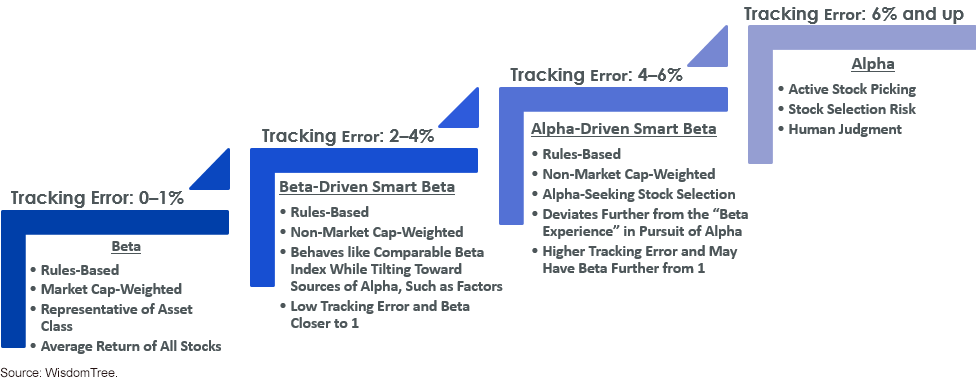WisdomTree’s New U.S. Multifactor Index: The Quest for Alpha



Before introducing WisdomTree’s new U.S. Multifactor Index, we think it is important to discuss why factor investing, after decades of academic research and support, is increasingly resonating with investors.
The Great Migration
The very first exchange-traded funds (ETFs)—and most of those that followed—were based on market capitalization-weighted indexes. Broad market indexing and ETFs have gained a large and growing share of the asset management marketplace due to investors’ desire to lower the costs of investing. In addition, most studies conclude that it’s difficult for traditional active managers to overcome the higher fees they charge.1
A Better Way to Index
Over 10 years ago, WisdomTree pioneered an income-tilted indexing strategy designed to provide broad beta exposure with alpha potential. WisdomTree recognized the value of marrying the benefits of the ETF structure, which can help bring tax efficiency, to an investment process that is built on rebalancing based on relative value, a departure from traditional market cap-weighted indexes.
As WisdomTree and other index providers proved the appeal of alternatively weighted indexes, more interest has developed around factor investing generally.
In recent years, traditional index providers have created stock indexes that tap into the specific factors that academic research suggests help explain higher returns or higher risk-adjusted returns over long holding periods: value, size, quality, momentum and low volatility.
In the original WisdomTree Indexes, launched in 2006 and 2007, we provided exposure to several of these well-regarded factors, apart from momentum, in a holistic way, while providing broad exposure to the various size segments of U.S. equity market. Factor analysis, for example, illustrates that our small-cap dividend ETF provided exposure to small caps (size), value, quality and low beta (low volatility) over the past decade.
The original WisdomTree ETFs were created to be broad-based, scalable solutions in categories deemed hard for managers to add value, such as U.S. large caps. In recent years, many have also exhibited fairly low levels of tracking error versus traditional market capitalization-weighted benchmarks.
A New Breed of Active and Alpha Strategies
Many investment managers describe the asset management spectrum as ranging from passive on one end of the continuum to active on the other. Because “smart beta” and factor strategies combine elements of passive and active, such strategies usually exist in the middle of this continuum. They have a similar goal as active managers—to try to outperform the market—but typically try to do so through a rules-based approach that can be codified into a stock index.
Another way to visualize this continuum is to consider how much potential tracking error one is willing to tolerate in the quest for alpha.
Segmenting the Hybrid “Factor Approach”: High and Low Alpha/Tracking Error Strategies

A Low Tracking Error Example of a Beta-Driven Smart Beta Approach
For some context, consider the WisdomTree Earnings Index, which weights companies once a year based on the aggregate earnings they’ve generated in the prior year. This Index had tracking error relative to the Russell 3000 Index of less than 2% over the past 10 years—a period in which the WisdomTree Earnings Index outperformed the Russell 3000 Index by 30 basis points (bps) per year.

WisdomTree’s Approach to Multifactor Indexing
While we believe that such fundamentally weighted indexes still hold out the potential to beat comparable cap-weighted indexes for the next 10 years, WisdomTree concedes that it may be possible to generate greater excess return over time by taking on greater active risk and concentrating index holdings in stocks that have greater exposure to the factors that have historically been associated with excess return. For investors interested in more active strategies, WisdomTree believes it is important to balance the risks that come with more active mandates. Some of these risks include:
- Balance of Factors: Are you over-weight in certain factors that become meaningfully out of favor for a long stretch of time? For instance, WisdomTree believes in the long-run efficacy of the value factor. Yet in the 10 years since WisdomTree launched its original fundamentally weighted Index families, value indexes lagged growth indexes by roughly 300 bps per year. A strategy that just tilts to value, therefore, faced a meaningful headwind over this period.
- Sector Bets: Are you meaningfully under-weight or over-weight in certain sectors that are a result of your factor tilts? For instance, minimum volatility and high-dividend indexes are inherently over-weight in bond proxy sectors, such as Utilities.
- Balance Benefits of Diversified Factor Approach: In a strategy that seeks to add alpha, one must take meaningful stock selection risk. We believe employing factor diversification improves the merits of stock selection and is a key element in shaping WisdomTree’s thinking on a more “active” index methodology.
We designed the WisdomTree U.S. Multifactor Index to target factors consistent with many “smart beta” approaches. But we believe our method of combining factors to maximize the potential for higher absolute and risk-adjusted returns is unique.
In our next post, we will outline the process of the new WisdomTree U.S. Multifactor Index in greater detail, including the introduction of the WisdomTree U.S. Multifactor Fund (USMF).
1SPIVA Scorecard.
Important Risks Related to this Article
There are risks associated with investing, including possible loss of principal. Investing in a Fund exposed to particular sectors increases the vulnerability to any single economic, political or regulatory development. This may result in greater share price volatility. Due to the investment strategy of the Fund, it may make higher capital gain distributions than other ETFs. Please read the Fund’s prospectus for specific details regarding the Fund’s risk profile.Neither WisdomTree Investments, Inc. nor its affiliates, nor Foreside Fund Services, LLC., or its affiliates provide tax advice. All references to tax matters or information provided on this site are for illustrative purposes only and should not be considered tax advice and cannot be used for the purpose of avoiding tax penalties. Investors seeking tax advice should consult an independent tax advisor.Dividends are not guaranteed, and a company currently paying dividends may cease paying dividends at any time.
Diversification does not eliminate the risk of experiencing investment losses.


Jeremy Schwartz has served as our Global Chief Investment Officer since November 2021 and leads WisdomTree’s investment strategy team in the construction of WisdomTree’s equity Indexes, quantitative active strategies and multi-asset Model Portfolios. Jeremy joined WisdomTree in May 2005 as a Senior Analyst, adding Deputy Director of Research to his responsibilities in February 2007. He served as Director of Research from October 2008 to October 2018 and as Global Head of Research from November 2018 to November 2021. Before joining WisdomTree, he was a head research assistant for Professor Jeremy Siegel and, in 2022, became his co-author on the sixth edition of the book Stocks for the Long Run. Jeremy is also co-author of the Financial Analysts Journal paper “What Happened to the Original Stocks in the S&P 500?” He received his B.S. in economics from The Wharton School of the University of Pennsylvania and hosts the Wharton Business Radio program Behind the Markets on SiriusXM 132. Jeremy is a member of the CFA Society of Philadelphia.

